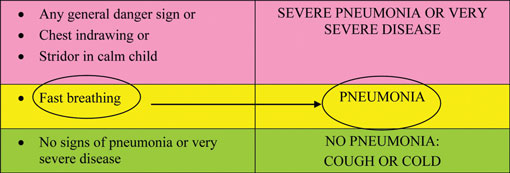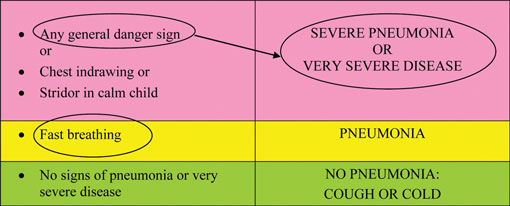4.2.1 How to use the classification table:
There are three possible classifications for a child with a cough or difficult breathing:
- Severe pneumonia or very severe disease, or
- Pneumonia, or
- No pneumonia: cough or cold.
To classify a cough or difficult breathing:
- Look at the top row in the classification table which sets out the signs you need to assess. If the child has a general danger sign (you learned about general danger signs in Study Session 1 of this Module), chest in-drawing or stridor, you should select the severe classification given in the top (pink) row of the table: severe pneumonia or very severe disease.
- If the child does not have the severe classification, look at the middle (yellow) row. If the child has fast breathing, but does not have signs in the top row of the classification table, you should select the classification in the middle (yellow) row: pneumonia (see Box 4.2 below)
Whenever you use a classification table, you should start with the top (pink) row.
Box 4.2 Classification of pneumonia
3 If the child does not have any of the signs in the top (pink) or middle (yellow) row, select the classification in the bottom (green) row: no pneumonia: cough or cold. If the child has signs from more than one row, always select the more serious classification.
If a child has cough, a general danger sign and fast breathing, how would you classify the child?
You should classify the child with the more serious classification – severe pneumonia or very severe disease (see Box 4.3).
Box 4.3 Classification of severe pneumonia
Now you have looked at the different classifications of cough or difficult breathing you are going to learn about the treatment that should be provided to the sick child.
4.2 Classifying coughs or difficulty in breathing


